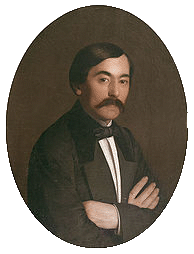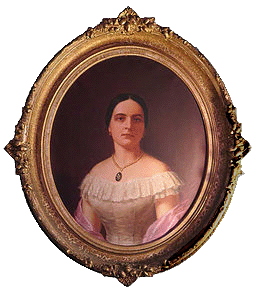
Pierre Gustave Toutant Beauregard
1818 - 1893

Biographical Chronology
28 May 1818
Beauregard is born in St. Bernard Parish to Jacques and Helene DeReggio Toutant-Beauregard ~ he is one of seven children. Although he always claimed Contreras as his birth place, he was not actually born there as is widely believed. His father Jacques purchased the property shortly after his birth. Originally, Contreras was known simply as the Toutant farm/plantation. It was not the custom of the 18th and early 19th century to name plantations. That custom developed in the mid to late 19th century. It was Beauregard's mother who renamed the property Contreras in honor of his first victory in battle.
The house was constructed of adobe brick. It was very low with a shingle roof and had 8 rooms - 4 in front and 4 in back. It had 4 fireplaces with 3 chimneys. The porch extended the full length of the front with a little balcony in the opening of the dining room. The property also included a barn and pigeon house.

Only Known Image of Contreras Plantation
- New Orleans Times-Democrat 1893 -

Young P.G.T. Beauregard
1834
Beauregard receives an appointed to the United States Military Academy at West Point, New York. English is his second language ~ French is his 'native' language.
1838
Beauregard graduates 2nd in his United States Military Academy "Class of '38" and is commissioned as a 2nd Lieutenant to the prestigious United States Army Corps of Engineers. At the time of his gradation and commissioning, Beauregard is signing his name as "G. T. Beauregard" and his fellow officers refer to him simply as: "Gus" ... he legally dropped from his official name "Pierre" and "de".
1841
Beauregard married Marie Antoinette Laure Villere (March 22, 1823 - March 21, 1850), the daughter of Jules Villere, a sugar cane planter in Plaquemines Parish and a member of one of the most prominent French Creole families in southern Louisiana. Marie's paternal grandfather was Jacques Villere, the second Governor of Louisiana. She was described as having blue eyes and fair skin.
Marie dies in March of 1850 while giving birth to Laure ... the couple had three children:

Judge Rene Toutant Beauregard
Captain ~ South Carolina Light Artillery
(1843 - 1910)

Marie Antoinette Laure Villere
Beauregard (1823 - 1850)

Laure Villere Beauregard
(1850 - 1884)
Henri Toutant Beauregard
Gen. Beauregard's Staff
(1845 - 1915)
(No Known Photo Exists)
It should be noted here that Judge Rene Toutant Beauregard is a "Founding Compatriot" and was very active in the activities of our Beauregard Camp 130, United Sons of Confederate Veterans.
1846 - 1850
Beauregard is assigned to the General Staff serving under General Winfield Scott during the Mexican-American War ~ serving alongside Robert E. Lee and George McClelland.

Pierre Gustave Toutant Beauregard During The Mexican-American War
Beauregard participates in the Battles of:
The Battle of Contreras
19 - 20 August 1847
The Battle of Churubusco
20 August 1847
The Battle of Chapultepec
12 - 13 September 1847
The Battle of Mexico City
08 - 15 September 1847
1853 - 1860
Beauregard is appointed Superintendent and given the task of repairing and completing the troubled New Orleans Customs House
1858
Beauregard is unsuccessful as a Reform Candidate running to become the Mayor of New Orleans.
1860
Beauregard is appointed Commandant of Cadets at the U. S. Military Academy at West Point.
January - April 1861
Beauregard resigns his U. S. Army Commission when Louisiana secedes in January of 1861; two months later he is among the 1st Officers commissioned as a Brigadier General, Provisional Army of the Confederate States. Immediately after being commissioned, he is dispatched to Charleston, South Carolina, with orders to fortify Charleston Harbor against an impending attack ordered by newly sworn in US President Abraham Lincoln.
As the U. S. Navy battle group sails from New York Harbor down the Atlantic coast, Beauregard arrives in Charleston on the 3rd of March, 1861, to discover that there are NO defensive positions setup nor are there any modern cannon available in the city. He transmits messages demanding all available cannon to be sent to Charleston as construction of a series of Forts are built around the harbor. By now, the Federals have abandoned all but one Fort in Charleston Harbor because there are not enough U. S. forces available to man all Federal harbor positions. As the Federals abandon the other forts, they destroy that fort's cannon, burn the gun carriages and render these forts non-operable without major repairs for months ... enraging the South Carolina government and the Provisional Confederate Congress in Montgomery, Alabama.
Beauregard quickly organizes the defenses of the harbor and sends messengers to the Major Robert Anderson US Army ~ Commander of Federal Forces in Charleston Harbor ~ to surrender all Federal forts with a guarantee of safe passages for United States troops out of South Carolina. The offer is rejected.
As the U. S. Navy Battle Group approaches South Carolina on the 12th of April, 1861, Beauregard orders the shot that opened the War for Southern Independence.

Assault on Ft. Sumter

General Pierre Gustave Toutant Beauregard, CSA
General Beauregard is acknowledged as the father of the Confederate Battle Flag. After the First Battle of Bull Run, he recognized the need for a distinct flag for the Confederate Armies on the battlefield due to the confusion caused by the similarities between the 1st National Flag of the Confederacy and the flag of the United States armies. Working together with other officers and several ladies sewing groups, a design was finalized and entered into production. With much fanfare and ceremony, Beauregard issued the new Battle Flags in November of 1861. Beauregard's personal flag was sewn by Ms. Jennie Carey (pictured below).

March 1861 - April 1865
After the victory at Fort Sumter, Beauregard commands various Confederate Armies across the South throughout the war. He is dispatched to different Confederate Armies by Confederate President Jefferson Davis, who has held a decade-long seething personal and professional animosity against Beauregard dating back to Davis' service as Secretary of War. Each time Beauregard achieved battlefield victory OR his name appearing in Southern newspapers, Davis flew into a rage and ordered his transfer once again. Beauregard would arrive at his new command just in time for the next major battle to commence.
Beauregard's battle record includes:
The Battle of Fort Sumter
~ 12 - 14 April, 1861 ~
The Battle of First Manassas
~ 21 July, 1861 ~
The Battle of Shiloh
~ 06 - 07 April, 1862 ~
The Siege of Corinth
~ 29 April - 30 May, 1862 ~
The First Battle of Charleston Harbor
~ 07 April 1863 ~
The First Battle of Fort Wagner
~ 10 - 11 July, 1863 ~
The Second Battle of Fort Wagner
~ 18 July, 1863 ~
The Second Battle of Charleston Harbor
~ 18 July - 07 September, 1863 ~
The Second Battle of Fort Sumter
~ 07 - 08 September, 1863 ~
Bermuda Hundred Campaign
~ May, 1864 ~
The Second Battle of Petersburg
~ 15 - 18 June, 1864 ~
The Battle of Bentonville
~ 19 - 21 March, 1865 ~
Throughout the war, Beauregard promotes submarines and torpedo boats ~ becoming the first American officer to foresee what the future of naval warfare will encompass 50+ years ahead of the rest of the world fully implementing his concepts of 20th century Naval Warfare.
Beauregard surrenders at Bentonville, North Carolina, on 26 April, 1865, when General Joseph Johnston surrenders the Army of Tennessee.
1865 - 1875
Returning home to New Orleans with $ 5.00 United States Dollars in his pocket.
His Engineering skills are put to use as Superintendent of the New Orleans, Jackson & Great Northern Railroad as well as the New Orleans & Carrollton Railroad. These railroads have very different names today and are both globally renowned ~ and quite profitable.




On February 21, 1893, nineteen friends of the recently deceased Pierre Gustave Toutant Beauregard met in New Orleans, and determined to raise funds for the erection of a commemorative monument. A collection of $197.50 was taken, and two days after this meeting, the Beauregard Monument Association (BMA) was incorporated.
An executive committee of fifty members was chosen to lead the effort. By May 16, 1893, less than three months after formation, the BMA had receipts of $ 2,343.25. But times were difficult and donations slowed. On October 20, 1895, a sham battle fought between veterans of both the blue and the grey was waged at New Orleans City Park, raising an additional $ 1,461.65. On April 19, 1899, the Ladies Confederate Memorial Association contributed another $ 35.00.
Money came by fits and spurts. A musical at Washington Artillery Hall netted $ 69.30; a jousting tournament at the Fair Grounds netted $ 139.90; the Army of Tennessee Camp № 2 donated $ 125.00, and the Louisiana Historical Society contributed $ 50.00.
There were bright spots as well. The United Daughters of the Confederacy, led by New Orleans Chapter № 72, raised $ 4,732.31. The State of Louisiana contributed $ 500.00. The estate of Mrs. C. Tilton donated $ 2,000. One of the most important gifts was the donation of $1,000.00 and a plot of land upon which to erect the monument, in October 1907, by the City Park Improvement Association.
At that time, the main entrance to City Park had been at City Park Avenue and Alexander Street. With the Park's boundaries now extending to Bayou St. John, a new entrance to the park at Esplanade Avenue was constructed, the Park working with the monument association to insure a harmonious entry. Thus was born Beauregard Circle.
By this time, enough funding had been collected to begin the monument. In December of 1908, the BMA contracted with noted artist Alexander Doyle of New York, for the cost of $ 15,000, to create a bronze equestrian statue of General Beauregard. A granite pedestal was to be created by the noted New Orleans firm of Albert Weiblen, for an additional $ 5,900. Mr. Doyle indicated that his low bid was due to his acquaintance with the general.
All in all, the Association raised $ 22,962.58, and after all expenses had been paid, was left with $ 311.15. On November 11, 1915, the Beauregard Monument was unveiled. Participating in the celebration were many old soldiers who were in town for the annual United Confederate Veterans convention, as well as school children from the nearby P. G. T. Beauregard School, family and friends of Beauregard, civic leaders, and the general public.
November 11, 2015, marked the centennial of the dedication of the Beauregard Monument, a fitting tribute to P. G. T. Beauregard and to the twenty two year effort of the Beauregard Monument Association to commemorate the most famous Creole soldier of New Orleans.










